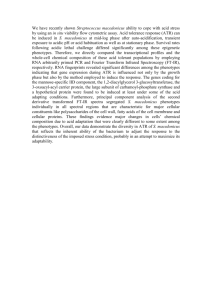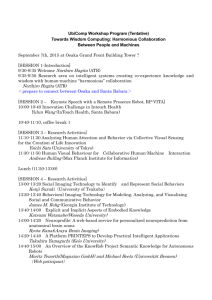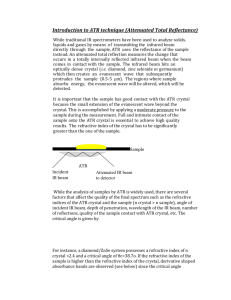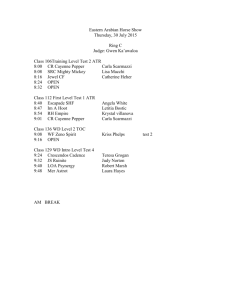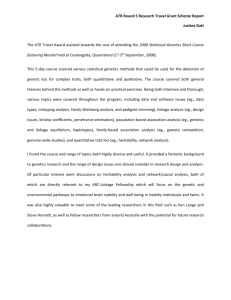Theory and Applications A N
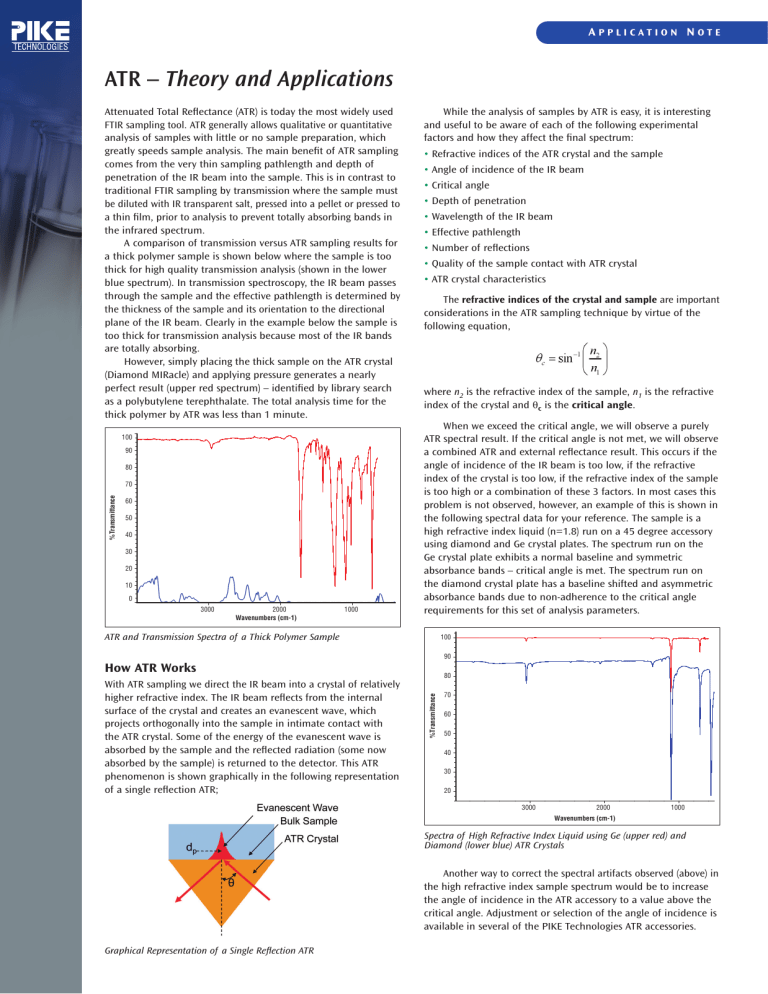
A P P L I C A T I O N N O T E
ATR – Theory and Applications
Attenuated Total Reflectance (ATR) is today the most widely used
FTIR sampling tool. ATR generally allows qualitative or quantitative analysis of samples with little or no sample preparation, which greatly speeds sample analysis. The main benefit of ATR sampling comes from the very thin sampling pathlength and depth of penetration of the IR beam into the sample. This is in contrast to traditional FTIR sampling by transmission where the sample must be diluted with IR transparent salt, pressed into a pellet or pressed to a thin film, prior to analysis to prevent totally absorbing bands in the infrared spectrum.
A comparison of transmission versus ATR sampling results for a thick polymer sample is shown below where the sample is too thick for high quality transmission analysis (shown in the lower blue spectrum). In transmission spectroscopy, the IR beam passes through the sample and the effective pathlength is determined by the thickness of the sample and its orientation to the directional plane of the IR beam. Clearly in the example below the sample is too thick for transmission analysis because most of the IR bands are totally absorbing.
However, simply placing the thick sample on the ATR crystal
(Diamond MIRacle) and applying pressure generates a nearly perfect result (upper red spectrum) – identified by library search as a polybutylene terephthalate. The total analysis time for the thick polymer by ATR was less than 1 minute.
100
90
80
70
60
50
40
30
20
10
0
3000 2000
Wavenumbers (cm-1)
ATR and Transmission Spectra of a Thick Polymer Sample
1000
How ATR Works
With ATR sampling we direct the IR beam into a crystal of relatively higher refractive index. The IR beam reflects from the internal surface of the crystal and creates an evanescent wave, which projects orthogonally into the sample in intimate contact with the ATR crystal. Some of the energy of the evanescent wave is absorbed by the sample and the reflected radiation (some now absorbed by the sample) is returned to the detector. This ATR phenomenon is shown graphically in the following representation of a single reflection ATR;
While the analysis of samples by ATR is easy, it is interesting and useful to be aware of each of the following experimental factors and how they affect the final spectrum:
• Refractive indices of the ATR crystal and the sample
• Angle of incidence of the IR beam
• Critical angle
• Depth of penetration
• Wavelength of the IR beam
• Effective pathlength
• Number of reflections
• Quality of the sample contact with ATR crystal
• ATR crystal characteristics
The refractive indices of the crystal and sample are important considerations in the ATR sampling technique by virtue of the following equation, where n
2 is the refractive index of the sample, index of the crystal and
θ c is the critical angle .
n
1 is the refractive
When we exceed the critical angle, we will observe a purely
ATR spectral result. If the critical angle is not met, we will observe a combined ATR and external reflectance result. This occurs if the angle of incidence of the IR beam is too low, if the refractive index of the crystal is too low, if the refractive index of the sample is too high or a combination of these 3 factors. In most cases this problem is not observed, however, an example of this is shown in the following spectral data for your reference. The sample is a high refractive index liquid (n=1.8) run on a 45 degree accessory using diamond and Ge crystal plates. The spectrum run on the
Ge crystal plate exhibits a normal baseline and symmetric absorbance bands – critical angle is met. The spectrum run on the diamond crystal plate has a baseline shifted and asymmetric absorbance bands due to non-adherence to the critical angle requirements for this set of analysis parameters.
100
90
80
70
60
50
40
30
20
3000 2000
Wavenumbers (cm-1)
1000
Spectra of High Refractive Index Liquid using Ge (upper red) and
Diamond (lower blue) ATR Crystals
Another way to correct the spectral artifacts observed (above) in the high refractive index sample spectrum would be to increase the angle of incidence in the ATR accessory to a value above the critical angle. Adjustment or selection of the angle of incidence is available in several of the PIKE Technologies ATR accessories.
Graphical Representation of a Single Reflection ATR
60
60
60
45
30
30
30
θ
ATR Sampling for n
2
= 1.5
λ = 1000 cm -1
N
45 1
45 3
10
1
3
10
1
3
10 d p
2.0
2.0
2.0
N/A
N/A
N/A
1.11
1.11
1.11
ZnSe, Diamond
θ n
1 c
= 2.4
= 38.7
d e
4.36
4.36
4.36
N/A
N/A
N/A
1.53
1.53
1.53
EPL
4.36
13.08
43.60
N/A
N/A
N/A
1.53
4.59
15.32
d p
1.7
1.7
1.7
N/A
N/A
N/A
1.02
1.02
1.02
AMTIR n
1
θ c
= 2.5
= 36.9
d e
3.38
3.38
3.38
N/A
N/A
N/A
1.30
1.30
1.30
EPL
3.38
10.15
33.84
N/A
N/A
N/A
1.30
3.91
13.03
Table 1: Pathlengths (stated in microns) of ATR Crystals at Various Angles of Incidence and Numbers of Reflections d p
0.66
0.66
0.66
1.2
1.2
1.2
0.51
0.51
0.51
Further useful consideration for ATR analysis is the depth of penetration ( d p
) of the IR beam into the sample. Technically, this is defined as the distance required for the electric field amplitude to fall to e -1 of its value at the surface and is further defined by: where λ is the wavelength of light and θ is the angle of incidence of the IR beam relative to a perpendicular from the surface of the crystal. Typical depth of penetration in ATR ranges from about 0.5
microns up to about 5 microns depending upon these experimental conditions. Shown in the graphical representation of the ATR phenomenon, the strength of the evanescent wave decays rapidly as we progress from the surface of the ATR crystal. If we wish to compare the sample absorbance of the ATR measurement with that of a transmission measurement, we need to calculate the volume of the evanescent wave, known as the effective penetration of the IR beam. The effective penetration ( d e are defined by:
), is unique for parallel polarization ( d e II
) and perpendicular polarization ( d
⊥
) and these
The effective penetration for an unpolarized IR beam is the average of the parallel and perpendicular penetration.
Generally, a single reflection ATR is ideal for qualitative analysis,
“What is my sample?” When we need to look at minor components of a sample for qualitative or quantitative analysis, then we need to increase the effective path length ( EPL ) by increasing the number of reflections ( N ) within the ATR crystal. The effective pathlength in ATR is derived by the following equation:
Ge
θ n
1 c
= 4.0
= 22.0
d e
0.61
0.61
0.61
1.59
1.59
1.59
0.32
0.32
0.32
An example of the benefit of increased number of reflections is shown in the following spectral data for the analysis of carbohydrate content in a soft drink sample. The upper red spectrum is run using a 10 reflection HATR accessory. The lower blue spectrum is run using a single reflection ATR using an identical scaling factor. Clearly the minor carbohydrate bands are more readily apparent in the multi-reflection ATR accessory.
0.7
0.6
0.5
0.4
0.3
0.2
0.1
0.0
1.0
0.9
0.8
1800 1600 1400
Wavenumbers (cm-1)
1200
Soft Drink Sample using 10 Reflection and 1 Reflection ATR
1000
For your convenience we have calculated theoretical values of depth of penetration, effective penetration, and effective path length for typical combinations of crystal materials, angles of incidence, and number of reflections shown in Table 1.
With the thin penetration of the evanescent wave into the sample, it is obvious that intimate contact of the sample be made onto the surface of the ATR crystal. For liquid or pliable samples, quality of sample contact with the ATR crystal is generally not a problem. For rigid, irregular shaped or porous samples, high pressure sufficient to deform the sample will increase the extent of sample contact and thereby increase sample absorbance. This is shown in the following spectral data collected for a porous foam polymer using a MIRacle ATR with ZnSe crystal.
EPL
0.61
1.84
6.14
1.59
4.76
15.85
0.32
0.97
3.23
0.50
0.45
0.40
0.35
0.30
0.25
0.20
0.15
0.10
0.05
0.00
4000 3000 2000
Wavenumbers (cm-1)
1000
Porous Foam Sample with High Pressure (upper red) and Low Pressure
(lower blue) d p
, for n
2
AMTIR
Diamond/ZnSe
Germanium
KRS-5
Silicon
ZnS
ZnSe n
1
2.5
2.4
4.0
2.37
3.4
2.2
2.4
Table 2: ATR Crystal Characteristics for FTIR Sampling
1.70
2.01
0.66
2.13
0.85
3.86
2.01
= 1.5
λ
= 1000 cm -1 , 45 deg, microns
The lower blue spectrum was collected with low pressure applied to the foam sample, whereas the upper red spectrum is produced with high pressure. The ATR absorbance using high pressure is about 10 times greater than with low pressure – all other sampling factors are identical. For rigid, crystalline, or hard, irregular surface samples we recommend a single reflection
Diamond MIRacle ATR because it is relatively easy to apply high pressure onto the small crystal (1.8 mm diameter) with the highpressure clamp, producing over 10,000 PSI.
The selection of the ATR crystal characteristics should be matched to the type of samples we run. Selection can be made to control depth of penetration of the IR beam, for hardness to prevent crystal damage, for desired spectral range and for acceptable pH range for acid or caustic samples. No individual crystal type will solve all problems, so PIKE Technologies offers a broad range of choices for ATR. Table 2 will give you some guidelines for selection of your ATR crystal.
Water Solubility, g/100g
Insoluble
Insoluble
Insoluble
0.05
Insoluble
Insoluble
Insoluble pH Range
1-9
1-14
1-14
5-8
1-12
5-9
5-9
Hardness,
Kg/mm
170
5,700
550
40
1150
240
120
6125 Cottonwood Drive Madison, WI 53719 • (608) 274-2721 • (608) 274-0103
(FAX)
• www.piketech.com • sales@piketech.com
(E-MAIL)
©2010 PIKE Technologies. All rights reserved.
